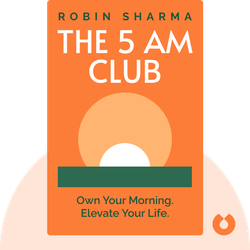Try Blinkist to get the key ideas from 7,000+ bestselling nonfiction titles and podcasts. Listen or read in just 15 minutes.
Start your free trial
Blink 3 of 8 - The 5 AM Club
by Robin Sharma

English in the Gutter: Then, Now, and Forever
Nine Nasty Words by John McWhorter is a fascinating and thought-provoking examination of the power and history of taboo language. McWhorter explores the complex social dynamics behind these words and asks provocative questions about how we use them.
There’s a long-standing Hollywood legend about the film Gone with the Wind. The story goes that the film’s producer, David Selznick, received a heavy fine when the movie was released.
You see, at the film’s climax, the leading star, Clark Gable, utters the now-classic line “Frankly, my dear, I don’t give a damn.” The rumor is that back in 1939 damn was such a shocking word that allowing it on screen was tantamount to a crime. So Selznick had to pay up.
But this just isn’t true. In reality, while damn and its compatriot word hell were both considered bawdy, neither was actually banned. In fact, they were treated as acceptable forms of profanity – a distinction they still hold today.
The key message here is: Damn and hell began as sinful and became secular.
In today’s pantheon of taboo words, damn and hell hold a curious place. While these two expletives are absolutely considered among the four-letter terms we label profane, they nonetheless feel a bit tame. This isn’t a recent development, either. Even by the 1900s, both expletives were used regularly and rarely met with more than mild and perfunctory disapproval.
Yet this wasn’t always the case. Travel back a few hundred years and these words would feel more provocative. In Europe during the Middle Ages and the Renaissance, Christian doctrine reigned supreme. Pious followers of the faith were careful to abide by the Second Commandment, which forbids taking the Lord’s name “in vain.” Pledging a trivial oath in the name of God or Jesus was strictly discouraged, which is why there’s a taboo around so-called swear words like Oh God or For God’s sake!
Moreover, this prohibition extended to cursing people or things in the name of God. Asking the Lord to condemn, or damn, a given frustration was a serious breach of decorum. This injunction also extended to the word hell, as this was the expected destination for any soul God would damn. So, while an especially pissed peasant might be tempted to shout, “God damn you to hell!” such a phrase carried a seriously sinful weight.
Of course, over time the religious connotations of these words began to fade, and their usage crept into everyday language. Damn and its cousin goddamn became so common that Joan of Arc even referred to the English people as “Goddams” for their frequent use of the phrase. For its part, hell became just another interjection, such as in the phrases What the hell? and Hell, why not?



Nine Nasty Words (2021) is a foul-mouthed exploration of our linguistic taboos. This title picks apart exactly why some words come to be profane.
Nine Nasty Words (2021) by John McWhorter delves into the history and significance of taboo language, offering insights that make it a worthwhile read. Here's why this book stands out:
It's highly addictive to get core insights on personally relevant topics without repetition or triviality. Added to that the apps ability to suggest kindred interests opens up a foundation of knowledge.
Great app. Good selection of book summaries you can read or listen to while commuting. Instead of scrolling through your social media news feed, this is a much better way to spend your spare time in my opinion.
Life changing. The concept of being able to grasp a book's main point in such a short time truly opens multiple opportunities to grow every area of your life at a faster rate.
Great app. Addicting. Perfect for wait times, morning coffee, evening before bed. Extremely well written, thorough, easy to use.
Try Blinkist to get the key ideas from 7,000+ bestselling nonfiction titles and podcasts. Listen or read in just 15 minutes.
Start your free trial
Blink 3 of 8 - The 5 AM Club
by Robin Sharma
What is the main message of Nine Nasty Words?
The main message of Nine Nasty Words is the fascinating history and social impact of profanity in the English language.
How long does it take to read Nine Nasty Words?
The reading time for Nine Nasty Words varies depending on the reader's speed. However, the Blinkist summary can be read in just 15 minutes.
Is Nine Nasty Words a good book? Is it worth reading?
Nine Nasty Words is a thought-provoking book that explores the power and evolution of taboo language. It's definitely worth reading!
Who is the author of Nine Nasty Words?
The author of Nine Nasty Words is John McWhorter.